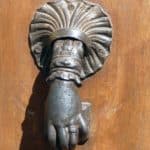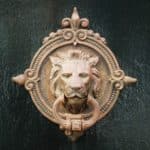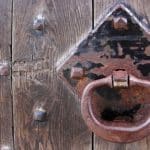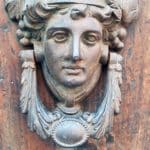Come and Knock on Our Door
by Jessica Kosinski
Today we take ringing the doorbell for granted when we visit most homes. Modern technology has even developed to the point where video technology allows us to see who is ringing. However, up until fairly recently most homes had door knockers that had to be manually operated for guests to announce themselves. Door knockers still exist today, but are used mainly as decorations. Let’s open the doors of history and take a peek back at how door knockers came to exist, how they have influenced our culture, and why they are still capable of capturing the interest of collectors, home restoration experts, and historians today.
Early Door Knockers Were Quite Basic
The Ancient Greek civilization was one of the first recorded groups to use door knockers similar to the door knockers we all know now. They began by employing iron bars as knockers, but that practice quickly stopped due to the fact that some guests chose to use the bars as weapons. Soon the bars were replaced by heavy rings that were affixed to strong metal plates. Simple ring and plate door knockers were used for a long time and can still be seen in some areas today. However, craftsmen eventually began adding shapes and designs to the plates that held the rings in place.
The Renaissance was a time period when the most changes were made to door knocker designs. Craftsmen continued to incorporate some designs into the plates, but they also discovered that the striking rings could take on design elements as well, leading to the creation of figural door knockers featuring depictions of people and animals. Throughout the late 1500s and 1600s, such door knocker designs gained swift popularity in countries like Germany, England, and Italy. Knockers from those countries made during that time period are often prized by collectors today.
Door Knockers as Luck and Status Symbols
With the introduction of figural and other door knocker designs came multi-purpose doorknockers. One extra purpose is related to superstition – in some countries near the Mediterranean it was believed that an amulet referred to as the “Hand of Fatima” could ward off evil. From that superstition it is believed that installing hand-shaped door knockers on front doors suddenly developed in several Mediterranean countries.
Many other countries, including England, began using door knockers for the entirely different purpose of advertising family status. The more elaborate door knockers were and the more of them there were in homes, the more money and status families supposedly had. Perhaps that is why a door knocker figures prominently in the popular Charles Dickens classic about the pitfalls of money and status, “A Christmas Carol.”
Particularly in Europe, door knockers have also taken on various different types of significance when installed on non-residential doors. For example, the door knocker at the Durham Cathedral in England represented sanctuary to any criminal who could strike it. Many criminals were either pardoned or aided in escaping after traveling to the Cathedral (or the church that stood before it) and striking the knocker. The practice was upheld from the 11th century until the early 17th century.
Popular Door Knocker Designs
Historically popular door knocker designs include hand and plain ring designs, but the most popular door knocker design of all time to this point has been the lion’s head design, which was first popularized in England and still adorns many doors across England today, as well as doors in other European countries. In fact, a lion’s head, which represents strength and bravery, guards the door of the home of the British Prime Minister. Not surprisingly, the lion’s head also made its way onto American doors in the early days of colonization. However, after the Revolutionary War the eagle door knocker became much more popular. Eagle door knockers are still proudly displayed on the doors of many U.S. homeowners today as well.
Door knocker values are often difficult to quantify because interest in various designs is purely subjective. Rarity of design certainly plays a role in determining value, but so does level of interest in a certain subject, such as the lion’s head popularity in England. The material from which a door knocker is made does greatly influence its value, regardless of its design. For example, brass and bronze door knockers tend to be more expensive than those made out of other materials, such as pewter. If you are only interested in purchasing a single door knocker for your front door as a decorative piece then your decision should be based on your personal preferences and your budget, as well as finding a design you think will go well with the style of both your door and your home.
If you want to seriously collect antique door knockers then you should look for knockers that are at least a century old … easier said than done. Most older door knockers were not dated or clearly marked, so it may be difficult to determine the age. The best way to make sure the door knocker you are interested in is truly antique is to purchase it from a reliable antique dealer or have it independently appraised. Also, be wary if the door knocker appears to be in good shape. Antique door knockers were not well protected from the elements like modern door knockers and should therefore show fair amounts of wear in most cases.
Jessica Kosinski has been a freelance writer specializing in writing short articles for 15 years. She is also an avid collector of both antique books and Star Wars memorabilia. Although she is not in the antiques industry professionally, she has learned a lot about antiques over the years by periodically helping out at her mom’s antiques shop in Greenville, NH. She currently balances maintaining the antiques shop’s Facebook page, www.facebook.com/MallofNE, and working on various freelance writing assignments. She can be reached at dementorskiss77@yahoo.com.











Related posts: